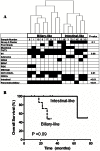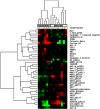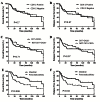Gene expression profiling of ampullary carcinomas classifies ampullary carcinomas into biliary-like and intestinal-like subtypes that are prognostic of outcome
- PMID: 23776447
- PMCID: PMC3679143
- DOI: 10.1371/journal.pone.0065144
Gene expression profiling of ampullary carcinomas classifies ampullary carcinomas into biliary-like and intestinal-like subtypes that are prognostic of outcome
Erratum in
- PLoS One. 2013;8(7). doi:10.1371/annotation/6afdd046-e1a7-4421-b7ec-0c9492ce2544. Zhi-Qin, Jiang [corrected to Jiang, Zhi-Qin]
Abstract
Background: Adenocarcinomas of the ampulla of Vater are classified as biliary cancers, though the exact epithelium of origin for these cancers is not known. We sought to molecularly classify ampullary adenocarcinomas in comparison to known adenocarcinomas of the pancreas, bile duct, and duodenum by gene expression analysis.
Methods: We analyzed 32 fresh-frozen resected, untreated periampullary adenocarcinomas (8 pancreatic, 2 extrahepatic biliary, 8 duodenal, and 14 ampullary) using the Affymetrix U133 Plus 2.0 genome array. Unsupervised and supervised hierarchical clustering identified two subtypes of ampullary carcinomas that were molecularly and histologically characterized.
Results: Hierarchical clustering of periampullary carcinomas segregated ampullary carcinomas into two subgroups, which were distinctly different from pancreatic carcinomas. Non-pancreatic periampullary adenocarcinomas were segregated into two subgroups with differing prognoses: 5 year RFS (77% vs. 0%, p = 0.007) and 5 year OS (100% vs. 35%, p = 0.005). Unsupervised clustering analysis of the 14 ampullary samples also identified two subgroups: a good prognosis intestinal-like subgroup and a poor prognosis biliary-like subgroup with 5 year OS of 70% vs. 28%, P = 0.09. Expression of CK7+/CK20- but not CDX-2 correlated with these two subgroups. Activation of the AKT and MAPK pathways were both increased in the poor prognostic biliary-like subgroup. In an independent 80 patient ampullary validation dataset only histological subtype (intestinal vs. pancreaticobiliary) was significantly associated with OS in both univariate (p = 0.006) and multivariate analysis (P = 0.04).
Conclusions: Gene expression analysis discriminated pancreatic adenocarcinomas from other periampullary carcinomas and identified two prognostically relevant subgroups of ampullary adenocarcinomas. Histological subtype was an independent prognostic factor in ampullary adenocarcinomas.
Conflict of interest statement
Figures




References
-
- Morris-Stiff G, Alabraba E, Tan YM, Shapey I, Bhati C, et al. (2009) Assessment of survival advantage in ampullary carcinoma in relation to tumour biology and morphology. Eur J Surg Oncol 35: 746–750. - PubMed
-
- Berberat PO, Kunzli BM, Gulbinas A, Ramanauskas T, Kleeff J, et al. (2009) An audit of outcomes of a series of periampullary carcinomas. Eur J Surg Oncol 35: 187–191. - PubMed
-
- Kohler I, Jacob D, Budzies J, Lehmann A, Weichert W, et al. (2012) Phenotypic and genotypic characterization of carcinomas of the papilla of Vater has prognostic and putative therapeutic implications. Am J Clin Pathol 135: 202–211. - PubMed
Publication types
MeSH terms
Grants and funding
LinkOut - more resources
Full Text Sources
Other Literature Sources
Medical
Molecular Biology Databases
Research Materials

